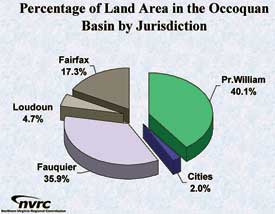| Land Use Planning in Prince William County Click on titles below for more information. |
Think Prince William is unique? Are there are solutions for Prince William, based on "lessons learned" elsewhere?
Land Use Planning Is a Contact Sport - So Get In the Game... Be part of Prince William's community dialogue on land use choices! We can also send our ideas in as a letter to the editor, and share our perspective with the community through local newspapers. If you are tired of message after message warning of plans to increase traffic and residential congestion, then it's time you became a player trying to fix the problem instead of an observer making comments on the sideline.
The Planning Office has information on land use proposals, including a Glossary of Planning and Land Use Terms. Land use issues are decided by the Board of County Supervisors and the Planning Commission. Link to the Prince William County Home Page and to the Online Comment Form. Learn About Virginia's Erosion and Sediment Control Program and Stormwater Management Program. What is Stale Zoning? Government needs public input to make sure resources are used where they are wanted and needed, services are distributed fairly and to ensure proper accounting for taxes and fees. Although broad community participation in public processes is essential to government, poor communication and overly complicated procedures are common obstacles. When broad involvement is limited, the result is a scenario that limits genuine participation and builds a foundation of conflict. Confusing processes and difficulties in accessing information lead to high levels of frustration and close the door on productive partnerships. For example, confusing information on the difference between the Zoning and the Comprehensive Plan land use classification can limit citizen’s ability to communicate with government. When communication breaks down, more often than not the result is officials who have a poor understanding of citizen’s needs and, thus, fail to follow through on opportunities that are important to local communities. The Comprehensive Plan, mandated by Section 15.2-2223 of the Code of Virginia, provides the foundation for the development and implementation of public policies including zoning and subdivision ordinances, public investments in capital facilities, development regulations, and others. A variety of accurate information is needed to develop an effective Comprehensive Plan and Section 15.2-2224 of the Code of Virginia mandates that the Planning Commission have studies conducted in support of the Plan. The Long-Range Land Use Map included in the Comprehensive Plan is a blueprint for countywide land uses. The map plans land uses and development densities, parcel by parcel, for the County. The zoning classification describes the land use government will allow by right – the uses a property owner has a legal claim to do without additional approvals such as rezoning or special use permits. When the zoning – or by right use of land parcels – does not agree with the Comprehensive Plan designation for a parcel, serious problems can result. The outcome is frequently the construction of projects that conflict with Prince William’s long-range growth and development plans. Prince William officials recognize the serious problems created by these inconsistencies. In 2000, officials directed staff to complete a study identifying properties where zoning did not match the Comprehensive Plan land use designation and where little or no development had occurred. The estimated time investment to complete this study was nearly 700 staff hours. The study was completed and many parcels throughout the County met the criteria. Staff sorted the identified parcels into four categories. Categories’ 1 and 2 included properties where actions to change the zoning to match the Comprehensive Plan designation were practical. Thirty properties fell into Categories 1 and 2: eleven in the Brentsville District; ten in Gainesville; four in Woodbridge; four in Dumfries; one in Coles. Unfortunately, government officials did not pursue the opportunity to rezone these properties and ensure that development would be consistent with the Comprehensive Plan. Since the time, development projects on some of these parcels have moved forward. Many of these projects have generated serious concerns from local communities. These include the development at Beaver Creek on Asdee Lane, Gateway Oaks on Route 15, Pembroke in the Linton Hall area and South Market outside Haymarket. The current development plans and projects for these properties clearly shows the long-term problems that are likely to result when government officials pass by opportunities to address conflicts between zoning and the Comprehensive Plan. Why officials failed to follow through with the next step in the comprehensive stale zoning analysis process is baffling. Government does not have to do this alone. Indeed, the need for broad stakeholder participation in development processes is magnified when government routinely bypasses opportunities to correct outdated zoning or pursue regulations that limit undesirable land uses countywide. Citizens are heavily invested in Prince William’s future and deserve the opportunity to participate in solutions to fix existing problems. County actions that take advantage of available tools, such as opportunities to make zoning fit the Comprehensive Plan, and initiatives to limit undesirable development proposals would receive strong support from Prince William communities.News
Links
Home | Upcoming Events | About Us | Resource Issues | News | Local Contacts Maps | Photos | Publications | Youth Education |FAQ's | Links | Membership |







